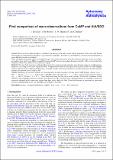Files in this item
First comparison of wave observations from CoMP and AIA/SDO
Item metadata
| dc.contributor.author | Threlfall, James William | |
| dc.contributor.author | De Moortel, Ineke | |
| dc.contributor.author | McIntosh, Scott | |
| dc.contributor.author | Bethge, Christian | |
| dc.date.accessioned | 2014-08-14T11:31:01Z | |
| dc.date.available | 2014-08-14T11:31:01Z | |
| dc.date.issued | 2013-08 | |
| dc.identifier | 101448398 | |
| dc.identifier | 9f774a6d-e52c-41ba-b006-d66a933bb381 | |
| dc.identifier | 84881449803 | |
| dc.identifier.citation | Threlfall , J W , De Moortel , I , McIntosh , S & Bethge , C 2013 , ' First comparison of wave observations from CoMP and AIA/SDO ' , Astronomy & Astrophysics , vol. 556 , A124 . https://doi.org/10.1051/0004-6361/201321782 | en |
| dc.identifier.issn | 0004-6361 | |
| dc.identifier.other | ORCID: /0000-0002-1452-9330/work/39526483 | |
| dc.identifier.uri | https://hdl.handle.net/10023/5153 | |
| dc.description | I.D.M. acknowledges support of a Royal Society University Research Fellowship. The research leading to these results has also received funding from the European Commission Seventh Framework Programme (FP7/2007-2013) under the grant agreements SOLSPANET (project No. 269299, www.solspanet.eu/solspanet). | en |
| dc.description.abstract | Context. Waves have long been thought to contribute to the heating of the solar corona and the generation of the solar wind. Recent observations have demonstrated evidence of quasi-periodic longitudinal disturbances and ubiquitous transverse wave propagation in many different coronal environments. Aims. This paper investigates signatures of different types of oscillatory behaviour, both above the solar limb and on-disk, by comparing findings from the Coronal Multi-channel Polarimeter (CoMP) and the Atmospheric Imaging Assembly (AIA) on-board the Solar Dynamics Observatory (SDO) for the same active region. Methods. We study both transverse and longitudinal motion by comparing and contrasting time-distance images of parallel and perpendicular cuts along/across active region fan loops. Comparisons between parallel space-time diagram features in CoMP Doppler velocity and transverse oscillations in AIA images are made, together with space-time analysis of propagating quasi-periodic intensity features seen near the base of loops in AIA. Results. Signatures of transverse motions are observed along the same magnetic structure using CoMP Doppler velocity (vphase = 600 → 750 km s-1, P = 3 → 6 min) and in AIA/SDO above the limb (P = 3 → 8 min). Quasi-periodic intensity features (vphase = 100 → 200 km s-1, P = 6 → 11 min) also travel along the base of the same structure. On the disk, signatures of both transverse and longitudinal intensity features were observed by AIA, and both show similar properties to signatures found along structures anchored in the same active region three days earlier above the limb. Correlated features are recovered by space-time analysis of neighbouring tracks over perpendicular distances of ≲2.6 Mm. | |
| dc.format.extent | 12 | |
| dc.format.extent | 1437887 | |
| dc.language.iso | eng | |
| dc.relation.ispartof | Astronomy & Astrophysics | en |
| dc.subject | Plasmas | en |
| dc.subject | Magnetohydrodynamics (MHD) | en |
| dc.subject | Sun: corona | en |
| dc.subject | Sun: oscillations | en |
| dc.subject | QB Astronomy | en |
| dc.subject.lcc | QB | en |
| dc.title | First comparison of wave observations from CoMP and AIA/SDO | en |
| dc.type | Journal article | en |
| dc.contributor.sponsor | Science & Technology Facilities Council | en |
| dc.contributor.sponsor | European Commission | en |
| dc.contributor.institution | University of St Andrews. Applied Mathematics | en |
| dc.contributor.institution | University of St Andrews. School of Mathematics and Statistics | en |
| dc.identifier.doi | https://doi.org/10.1051/0004-6361/201321782 | |
| dc.description.status | Peer reviewed | en |
| dc.identifier.grantnumber | ST/K000950/1 | en |
| dc.identifier.grantnumber | 269299 | en |
This item appears in the following Collection(s)
Items in the St Andrews Research Repository are protected by copyright, with all rights reserved, unless otherwise indicated.

